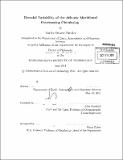| dc.contributor.advisor | John Marshall. | en_US |
| dc.contributor.author | Buckley, Martha Weaver | en_US |
| dc.contributor.other | Massachusetts Institute of Technology. Dept. of Earth, Atmospheric, and Planetary Sciences. | en_US |
| dc.coverage.spatial | l------ | en_US |
| dc.date.accessioned | 2012-01-30T17:01:11Z | |
| dc.date.available | 2012-01-30T17:01:11Z | |
| dc.date.copyright | 2011 | en_US |
| dc.date.issued | 2011 | en_US |
| dc.identifier.uri | http://hdl.handle.net/1721.1/68891 | |
| dc.description | Thesis (Sc. D.)--Massachusetts Institute of Technology, Dept. of Earth, Atmospheric, and Planetary Sciences, 2011. | en_US |
| dc.description | Cataloged from PDF version of thesis. | en_US |
| dc.description | Includes bibliographical references (p. 141-149). | en_US |
| dc.description.abstract | In the mean, the Atlantic Ocean transports 1 to 1.5 PW of heat northward, and estimates suggest that 60% of this heat transport is associated with a circulation that reaches the cold waters of the abyss. Due to the role of the Atlantic Meridional Overturning Circulation (AMOC) in ocean heat transport, numerous studies have suggested that AMOC variability plays a role in climate variability on a wide range of timescales. My focus is AMOC and ocean buoyancy variability on decadal timescales. Decadal variability of sea surface temperature (SST) has been observed in the instrumental record and climate proxy data and is thought to be linked to variability in the AMOC. On the other hand, according to the thermal wind relation, buoyancy anomalies on the boundaries lead to anomalies in the AMOC, a fact that has been utilized in order to reconstruct the MOC at 26.5'N using data collected by the RAPID array. Here, I study decadal AMOC and buoyancy variability in a coupled and oceanonly GCMs run in idealized geometries. I focus on understanding the mechanisms of decadal variability of the AMOC, both the role of the AMOC in creating decadal buoyancy anomalies and the response of the AMOC to buoyancy anomalies. I find that decadal AMOC variability is driven by buoyancy anomalies near the western boundary of the subpolar gyre. When a buoyancy anomaly hits the western boundary, it is advected southward by the deep western boundary current. Via the thermal wind relation, buoyancy anomalies on the boundaries result in anomalies in the shear of the zonally integrated meridional velocity. Buoyancy anomalies on the eastern boundary are observed to be negligible, except in the subpolar gyre, indicating that negative (positive) buoyancy anomalies on the western boundary lead to a spin up (down) of the AMOC. The AMOC is observed to respond passively to buoyancy anomalies on the western boundary: although variability of the AMOC does lead to variability in the meridional transport of heat and salt, these transports are not responsible for creating the buoyancy anomalies on the western boundary that drive the AMOC variability. While the structure of the buoyancy anomalies is found to change with model bathymetry, in all the models studied the buoyancy variability is due to an oceanonly mode. In some cases, the mlode is weakly damped (large Q-factor), resulting in regular, predictable oscillations. In other cases, the ocean-only imode is highly damped (small Q-factor) and must be excited by stochastic atmospheric variability, resulting in irregular, less predictable variability. In nature, buoyancy anomalies along the western boundary might be created ill a number ways, including local baroclinic instability, baroclinic Rossby waves impinging on the western boundary, advection of anomalies from tropics, and advection/ propagation of convectively created anomalies from polar regions. In our models the dominant sources of buoyancy anomalies on the western boundary are local baroclinic instability and the propagation of baroclinic Rossby waves originating near the eastern boundary. However, we expect the response of the AMOC to decadal buoyancy anomalies on the western boundary to be similar regardless of the origin of these buoyancy anomalies. | en_US |
| dc.description.statementofresponsibility | by . | en_US |
| dc.format.extent | 149 p. | en_US |
| dc.language.iso | eng | en_US |
| dc.publisher | Massachusetts Institute of Technology | en_US |
| dc.rights | M.I.T. theses are protected by
copyright. They may be viewed from this source for any purpose, but
reproduction or distribution in any format is prohibited without written
permission. See provided URL for inquiries about permission. | en_US |
| dc.rights.uri | http://dspace.mit.edu/handle/1721.1/7582 | en_US |
| dc.subject | Earth, Atmospheric, and Planetary Sciences. | en_US |
| dc.title | Decadal variability of the Atlantic Meridional Overturning Circulation | en_US |
| dc.title.alternative | Decadal variability of the AMOC | en_US |
| dc.type | Thesis | en_US |
| dc.description.degree | Sc.D. | en_US |
| dc.contributor.department | Massachusetts Institute of Technology. Department of Earth, Atmospheric, and Planetary Sciences | |
| dc.identifier.oclc | 773575791 | en_US |
